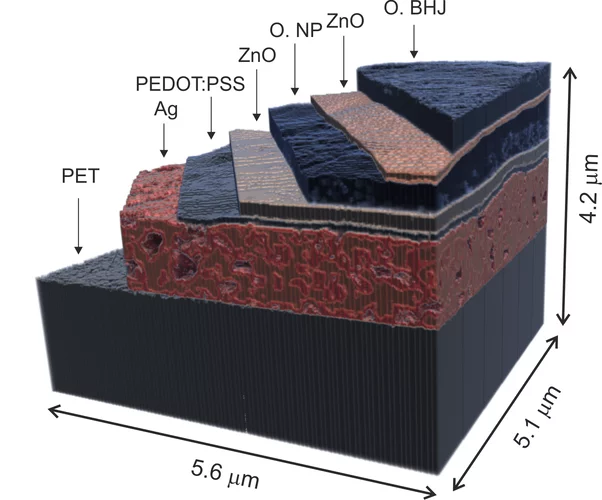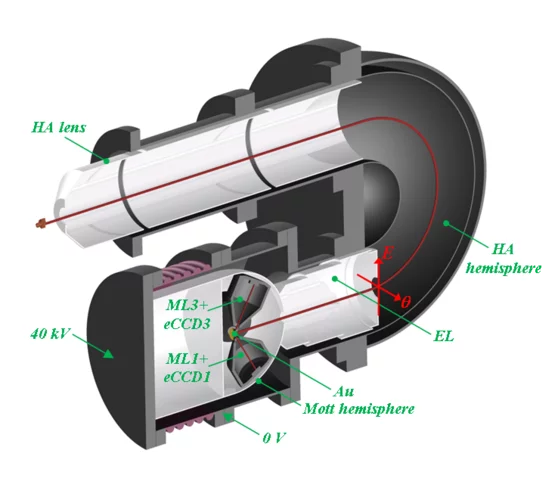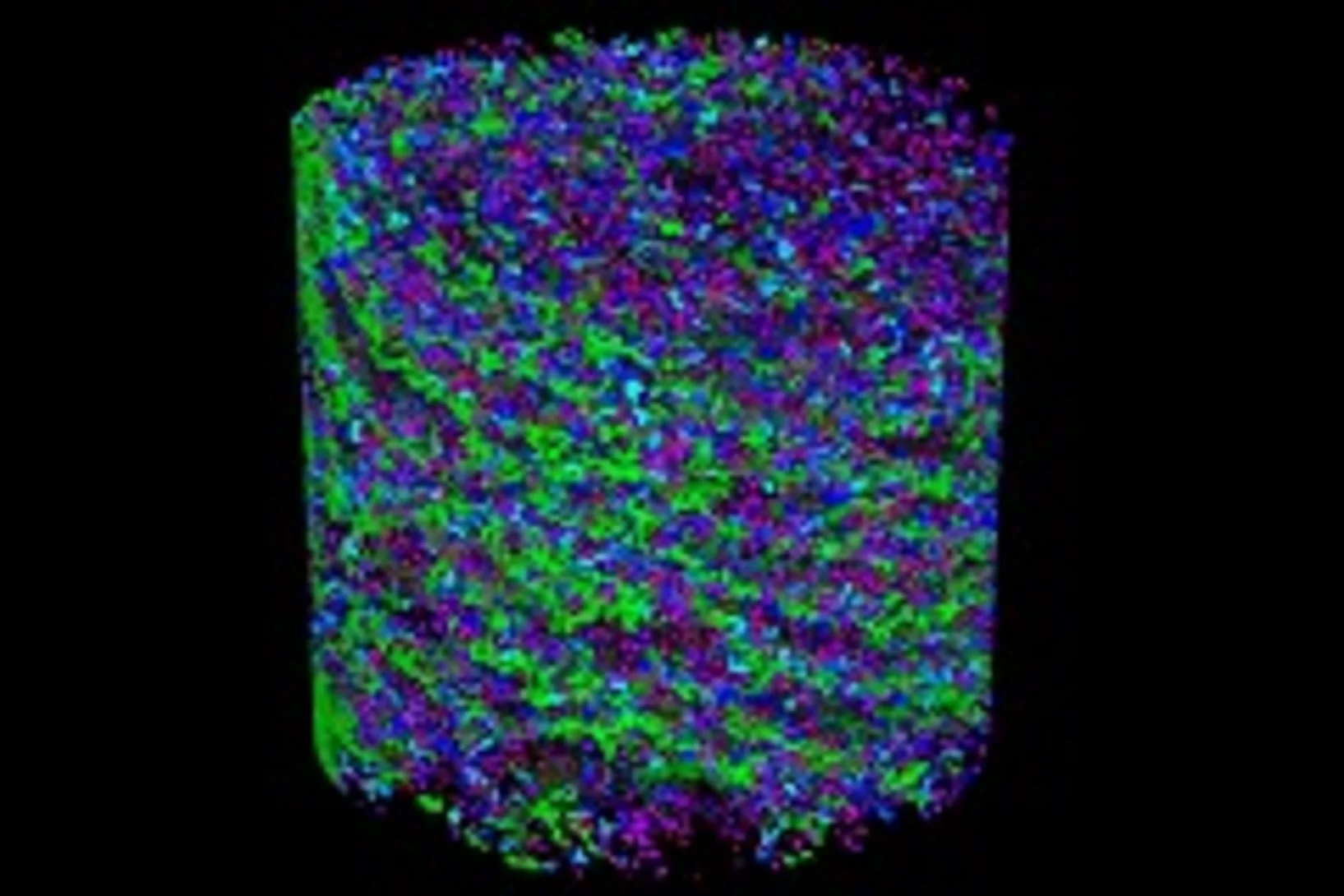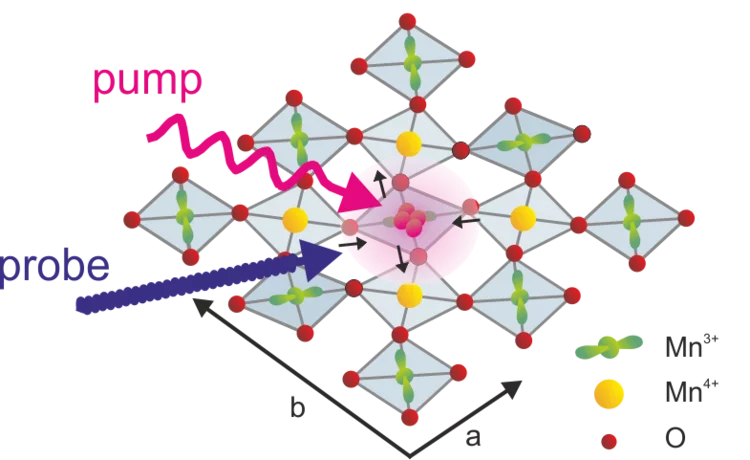X-ray nanotomography aids the production of eco-friendly solar cells
Polymer solar cells are in the spotlight for sustainable energy production of the future. Characterization of these devices by X-ray nanotomography helps to improve their production using environmentally friendly materials.
Cousin des Elektrons nach 86 Jahren gefunden
Physiker des Paul Scherrer Instituts PSI gemeinsam mit Kollegen aus China sowie von der ETH Zürich und der ETH Lausanne EPFL haben bei Versuchen an der Synchrotron Lichtquelle Schweiz SLS ein Teilchen nachgewiesen, dessen Existenz bereits vor 86 Jahren vorausgesagt worden war. Es handelt sich um ein Mitglied der Teilchenfamilie, zu denen auch das Elektron, der Träger elektrischer Ströme, gehört. Anders als das Elektron hat das neue Teilchen aber keine Masse und es kommt nur in einer bestimmten Klasse von Materialien vor, die als Weyl-Halbmetalle bezeichnet werden.
Controlling tunnelling in methane loss from acetone ions by deuteration
At the imaging Photoelectron Photoion Coincidence (iPEPICO) endstation of the VUV beamline evidence of H-atom tunneling was shown.
Struktur der Betonkrankheit
entschlüsselt
Wenn Brücken, Staumauern und andere Bauwerke aus Beton nach einigen Jahrzehnten von dunklen Rissen durchzogen sind, dann ist die sogenannte Betonkrankheit die Ursache. Wie das Material, das in diesen Rissen entsteht, auf der Ebene einzelner Atome aufgebaut ist, haben jetzt Forschende des Paul Scherrer Instituts PSI und der Empa entschlüsselt - und dabei eine bislang unbekannte kristalline Anordnung der Atome entdeckt.
Röntgenforschung im Ufo
Die Synchrotron Lichtquelle Schweiz SLS fällt zuerst durch ihr markantes Gebäude auf. Innen beeindruckt sie mit Spitzenforschung. Ein Streifzug durch die Welt, in der Elektronen Slalomkurse einlegen und Röntgenstrahlen Proteine entschlüsseln.
Methane storage in flexible metal–organic frameworks with intrinsic thermal management
As a cleaner, cheaper, and more globally evenly distributed fuel, natural gas has considerable environmental, economic, and political advantages over petroleum as a source of energy for the transportation sector. Despite these benefits, its low volumetric energy density at ambient temperature and moderate pressure presents substantial challenges, particularly for light-duty vehicles with little space available for on-board fuel storage.
Fermi states and anisotropy of Brillouin zone scattering in the decagonal Al–Ni–Co quasicrystal
Quasicrystals (QCs) are intermetallic alloys where excellent long-range order coexists with lack of translational symmetry in one or more dimensions. These materials have a high potential in application as a material for a solar cells, hydrogen storage applications, heat insulating layers, and others.
2015 Otto Kratky award
Marianne Liebi was awarded the 2015 Otto Kratky award by the Helmholtz-Centre Berlin for excellence in the field of small-angle X-ray scattering (SAXS) analysis. The award was bestowed in the last SAS2015 conference in Berlin. Marianne is a postdoctoral fellow in the coherent X-ray scattering group (CXS) in PSI, carrying out research in scanning SAXS measurement and analysis in 2D and 3D. Image credit ©HZB/Michael Setzpfandt
Der Schlüssel für schnelles Aufladen einer Lithiumionen-Batterie
Lithiumeisenphosphat-Batterien sind sehr langlebig und lassen sich relativ schnell aufladen. Forschende des Paul Scherrer Instituts PSI, der ETH Zürich und der Forschungs- und Entwicklungslabore von Toyota zeigen in einer neuen Studie die Gründe für diese Eigenschaften. Die Erkenntnisse wurden möglich dank Messungen mit einer neuen Methode an der Synchrotron Lichtquelle Schweiz SLS des PSI.
Auf der Suche nach dem kleinsten Bit
Für immer kompaktere Speichermedien der Zukunft müssen magnetische Bereiche – die Speicherbits – immer kleiner werden. Doch wie klein kann ein Magnet überhaupt werden? Frithjof Nolting und seine Kollegen erforschen am Paul Scherrer Institut PSI den Nanomagnetismus.
In Situ Serial Crystallography Workshop at the SLS
The Macromolecular Crystallography group at SLS is organizing a three days workshop on in situ serial crystallography (http://indico.psi.ch/event/issx) between November 17 and 19, 2015. It will be dedicated in the presentation of a novel method facilitating the structure determination of membrane proteins, which are highly important pharmaceutical targets but are difficult to handle using 'classical' crystallographic tools. Designed for 20 Ph.D. students, postdocs and young scientists from both academia and industry, the workshop will consist of introductory lectures, followed by hands-on practicals on in meso or lipidic cubic phase (LCP) crystallization, on in situ serial crystallography data collection using a micro-sized beam and on data processing.
New insight into receptor signalling
A team of 72 investigators across 25 institutions including researchers from the Paul Scherrer Institut obtained the X-ray structure of a rhodopsinàarrestin complex, which represents a major milestone in the area of G-protein-coupled-receptor (GPCR), a protein family recognized in the award of the 2012 Nobel Prize in Chemistry.
Element-Specific X-Ray Phase Tomography of 3D Structures at the Nanoscale
Recent advances in fabrication techniques to create mesoscopic 3D structures have led to significant developments in a variety of fields including biology, photonics, and magnetism. Further progress in these areas benefits from their full quantitative and structural characterization.
Nanoscale switch for vortex polarization mediated by Bloch core formation in magnetic hybrid systems
Vortices are fundamental magnetic topological structures characterized by a curling magnetization around a highly stable nanometric core.
Correlating the Core-Shell Composition and the Surface Structure to the Magnetic Properties for Magnetite-Maghemite Nanoparticles in the 5-15 nm Range
Very small superparamagnetic iron oxide nanoparticles were characterized by innovative synchrotron X-ray total scattering methods and Debye function analysis, developed at the X04SA Materials Science beamline of SLS.
Reduction of Mn19 Coordination Clusters on a Gold Surface
The surface-induced changes of the oxidation state and magnetic properties of Mn ion clusters have been probed by X-ray absorption spectroscopy and X-ray magnetic circular dichroism.
Concept of a multichannel spin-resolving electron analyzer based on Mott scattering
The spin of electron plays a crucial role in many physical phenomena, ranging from the obvious example of magnetism, via novel materials for spintronics applications, to high-temperature superconductivity. Spin- and angle-resolved photoelectron spectroscopy (SARPES) gives the most direct access to the spin aspects of the electronic structure, but the one-channel detection principle of all presently available SARPES spectrometers severely limits their efficiency. A team of Swiss and Russian scientists has developed a revolutionary concept of a multichannel electron spin detector based on Mott scattering as the spin selective process and imaging-type electron optics.
Fermi Surface of Three-Dimensional La1−xSrxMnO3 Explored by Soft-X-Ray ARPES: Rhombohedral Lattice Distortion and its Effect on Magnetoresistance
A research team led by scientists from the Swiss Light Source has for the first time established three-dimensional (3D) electronic structure of the perovskite compound La1−xSrxMnO3 connected with its colossal magnetoresistance. Instrumental for this study has been the use of the new experimental technique of soft-x-ray ARPES, available at the ADRESS beamline, with its intrinsically sharp definition of 3D electron momentum.
Gemeinsam statt einsam
An SwissFEL und SLS Biomoleküle entschlüsseln: Proteine sind ein begehrtes, aber widerspenstiges Forschungsobjekt. Eine für Freie-Elektronen-Röntgenlaser wie dem zukünftigen SwissFEL des PSI entwickelte Methode soll ihre Erforschung nun ein grosses Stück vorantreiben. Dabei werden viele identische, kleine Proteinproben in kurzen Abständen hintereinander mit einem Röntgenstrahl durchleuchtet. Damit wird ein bisheriges Hauptproblem der Erforschung von Proteinen umgangen: Proben in ausreichender Grösse herzustellen.
Aus dem Innern einer Eierschale
Winzige Bläschen im Innern von Eierschalen liefern die Stoffe, die das Wachstum der Schale stimulieren und steuern. Mit einer neuartigen Tomografie-Technik haben Forschende des Paul Scherrer Instituts PSI, der ETH Zürich und des niederländischen AMOLF-Instituts diese Bläschen erstmals in 3D abbilden können. Sie heben damit eine alte Einschränkung tomografischer Bilder auf und hoffen, dass eines Tages auch die Medizin von ihrer Methode profitiert.
Forschen Richtung Zukunft
Interview mit Gabriel AeppliSeit 2014 ist Gabriel Aeppli Leiter des Forschungsbereichs Synchrotronstrahlung und Nanotechnologie am PSI. Zuvor hat der gebürtige Schweizer in London ein führendes Forschungszentrum für Nanotechnologie aufgebaut. Im Interview erläutert Aeppli wie sich die Forschungsansätze der Zukunft an den Grossforschungsanlagen des PSI umsetzen lassen und spricht über seinen Blick auf die Schweiz.
Multiresolution X-ray tomography, getting a clear view of the interior
Researchers at PSI have developed a technique that combines tomography measurements at different resolution levels to allow quantitative interpretation for nanoscale tomography on an interior region of interest of the sample. In collaboration with researchers of the institute AMOLF in the Netherlands and ETH Zurich in Switzerland they showcase their technique by studying the porous structure within a section of an avian eggshell. The detailed measurements of the interior of the sample allowed the researchers to quantify the ordering and distribution of an intricate network of pores within the shell.
Gespaltener Röntgenblitz zeigt schnelle Vorgänge
SwissFEL, der Röntgenlaser des PSI, wird die einzelnen Schritte sehr schneller Vorgänge sichtbar machen. Ein neues Verfahren soll besonders genaue Experimente ermöglichen: Dabei werden die einzelnen Röntgenblitze in mehrere Teile aufgespalten, die nacheinander am Untersuchungsobjekt ankommen. Das Prinzip des Verfahrens erinnert an die Ideen der frühesten Hochgeschwindigkeitsfotografie.
Nanometer in 3-D
Forschende haben 3-D-Bilder winziger Objekte erzeugt und konnten dabei sogar 25 Nanometer grosse Details (1 Nanometer = 1 Millionstel eines Millimeters) sichtbar machen. Dabei haben sie nicht nur die Form der Untersuchungsgegenstände bestimmen können, sondern auch gezeigt, wie ein bestimmtes chemisches Element (Kobalt) darin verteilt ist und ob es in einer chemischen Verbindung oder in Reinform vorliegt.
Vorbereitet für den SwissFEL
Seit Jahren testen PSI-Forschende Experimentiermethoden, die am Röntgenlaser SwissFEL Einblicke in neuartige Materialien für elektronische Geräte ermöglichen werden. Mit einem besonderen Trick bringen sie dafür die Synchrotron Lichtquelle Schweiz SLS des PSI dazu, Licht zu erzeugen, das ähnliche Eigenschaften hat, wie dasjenige des SwissFEL. So konnten die Forschenden zeigen, dass die geplanten Experimente im Grundsatz möglich sind und den Bau des entsprechenden Messplatzes am SwissFEL vorschlagen.
Ultrafast structural dynamics of the Fe-pnictide parent compound BaFe2As2
Understanding the interplay of the various degrees of freedom such as the electrons, spins and lattice is essential for many complex materials, including the high-temperature superconductors.
Batman zeigt den Weg zu kompakter Datenspeicherung
Forschenden am Paul Scherrer Institut PSI ist es gelungen, winzige magnetische Strukturen mit Laserlicht umzuschalten und die Veränderung zeitlich zu verfolgen. Dabei blinkte kurz ein nanometergrosser Bereich auf, der skurrilerweise an das Fledermaus-Symbol von Batman erinnert. Die Forschungsergebnisse könnten die Datenspeicherung auf Festplatten kompakter, schneller und effizienter machen.
Nanoscale sub-100 picosecond all-optical magnetization switching in GdFeCo microstructure
Ultrafast magnetization reversal driven by femtosecond laser pulses has been shown to be a promising way to write information. Seeking to improve the recording density has raised intriguing fundamental questions about the feasibility of combining ultrafast temporal resolution with sub-wavelength spatial resolution for magnetic recording. Here we report on the experimental demonstration of nanoscale sub-100 ps all-optical magnetization switching, providing a path to sub-wavelength magnetic recording.
A revealing mixture: The surface of an oxide insulator can host two distinct types of conducting electrons
Strontium titanate, SrTiO3, is an important material for the realization of next-generation electronic devices. A famous example is the interface of LaAlO3 grown on SrTiO3, which is metallic and magnetic at its interface, even though the individual compounds are insulating and nonmagnetic in bulk form. The physics behind how novel interface states form on SrTiO3 - and how they become endowed with such surprising properties - is not well understood.
Square dance of the atoms: Shedding light on ultrafast phase transitions
The exploration of the interaction of structural and electronic degrees of freedom in strongly correlated electron systems on the femtosecond time scale is an emerging area of research. One goal of these studies is to advance our understanding of the underlying correlations, another to find ways to control the exciting properties of these materials on an ultrafast time scale.





























